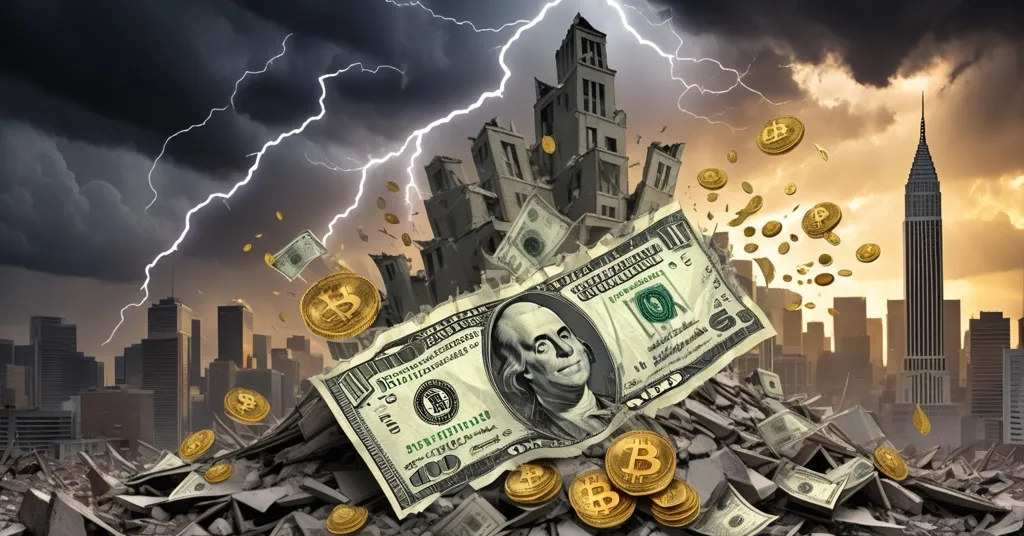U.S. Debt Crisis: Balaji Warns of $175T Disaster as Bitcoin and Gold Surge

U.S. Debt Crisis: Balaji Srinivasan Sounds the Alarm on a $175 Trillion Disaster as Bitcoin and Gold Gain Ground
The U.S. financial system is staring down a staggering $175 trillion debt burden, far beyond the official $36.2 trillion figure, according to former Coinbase CTO Balaji Srinivasan, who warns of an inevitable “national bankruptcy” through inflation and currency devaluation. With the U.S. dollar suffering its worst decline in decades during 2025, trust in fiat is crumbling, driving a surge in hard assets like Bitcoin and gold as hedges against a broken system.
- Hidden Debt Monster: Official U.S. debt is $36.2 trillion, but unfunded liabilities like Social Security push it to $175.3 trillion.
- Dollar in Freefall: U.S. Dollar Index plummets 10.8% in H1 2025, the worst since 1973, fueled by debt and policy chaos.
- Hard Asset Boom: Bitcoin ETFs hit $135 billion, crypto market reaches $3.5 trillion, while central banks hoard gold.
The True Scale of the U.S. Debt Time Bomb
Let’s get straight to the gut punch: the U.S. debt situation is a catastrophe waiting to detonate. As of June 2025, the U.S. Treasury pegs the national debt at $36.2 trillion—a number that’s already stomach-churning. But Balaji Srinivasan, a heavyweight in the tech and crypto world, points to a far uglier truth. When you account for unfunded liabilities—those legally binding future obligations like Social Security and Medicare benefits that aren’t currently backed by cash—the total obligation skyrockets to $175.3 trillion, according to the 2024 Financial Report of the U.S. Government. For those new to the term, unfunded liabilities are essentially promises to pay out massive sums down the road, often calculated over an “infinite horizon,” without a penny saved today to cover them. Think of it as maxing out a credit card for your grandkids’ healthcare with no plan to pay the bill.
Srinivasan doesn’t pull punches on the implications of this mess.
“There is no fix. It is a write-off. A national bankruptcy.”
His take is brutal but grounded in harsh reality, as highlighted in discussions about the unfixable nature of U.S. debt. The U.S. can’t tax or grow its way out of a hole this deep. Instead, the likely escape route is printing money—flooding the system with fresh dollars to dilute the debt’s value. The catch? That sparks inflation and erodes the currency’s worth, a silent default that screws savers and wage earners without the government ever admitting defeat. Consider the debt-to-GDP ratio, a key measure of a country’s financial health that compares what it owes to what it produces annually. By the end of 2025, this ratio is projected to exceed 100%, up from 98.2% in 2020, signaling that the U.S. owes more than its entire yearly economic output. Historically, crossing this threshold raises red flags about solvency, and markets worldwide are taking notice.
The Dollar’s Historic Collapse in 2025
Feeling the sting at the gas pump or noticing your overseas vacation costs more? Blame the U.S. dollar’s nosedive. In the first half of 2025, the U.S. Dollar Index (DXY)—a benchmark tracking the greenback against major currencies like the euro and yen—plunged 10.8%, marking its worst performance since 1973, the year the dollar fully broke free from gold backing after the Bretton Woods system collapsed. To break it down, when the DXY drops, your dollar buys less abroad and often at home too. Specific losses are eye-watering: 14.4% against the Swiss franc, 13.4% against the euro, 10.5% against the Japanese yen, and 9.6% against the British pound. The Bloomberg Dollar Spot Index logged six consecutive monthly declines, a losing streak unseen in recent memory, as detailed in recent expert analysis on the dollar’s decline.
What’s behind this meltdown? A perfect storm of fiscal irresponsibility and policy missteps. Soaring debt levels, new tariffs in 2025 that jack up import costs, and hints of Federal Reserve rate cuts from June 2025 meeting minutes are all dragging the dollar down. Then there’s the trade deficit—$1.2 trillion in 2024, with $3.3 trillion in imported goods—widening the gap between what the U.S. buys and sells, further pressuring the currency. A weaker dollar means higher prices for everything from electronics to oil, fueling inflation that hits everyday wallets. Globally, confidence in the dollar as the world’s reserve currency is cracking—its share of foreign exchange reserves fell to 57.4% by Q4 2024, down from 66% in 2014, per IMF data. This dedollarization trend isn’t just a statistic; it’s a sign that the world is losing faith in Uncle Sam’s IOUs.
Adding insult to injury, the cost of servicing this debt is ballooning. Net interest payments are projected at $952 billion for 2025, consuming 18% of federal revenue and 3.2% of GDP, according to the Congressional Budget Office. By 2026, that could surpass $1 trillion—cash that’s not fixing bridges or funding schools but just paying off yesterday’s borrowing. Economic growth, which could ease the burden, is limping along at a projected 1.4% for Q2 2025, per the Federal Reserve Bank of Philadelphia. The U.S. is trapped: print more money and risk hyperinflation, or tighten the belt and choke off any hope of recovery. Neither path looks like a winner, as explored in broader discussions on the national debt crisis.
Policy Chaos and Geopolitical Shifts
Don’t expect policymakers to ride in with a magic fix. Proposals like Donald Trump’s “Big Beautiful Bill” to extend tax cuts and ramp up spending could slap another $3.8 trillion onto the federal debt over a decade, per CBO estimates. Even high-profile figures like Elon Musk have called out such fiscal recklessness, aligning with Srinivasan’s warnings about stacking more debt on an already crumbling foundation, a perspective echoed in Srinivasan’s views on national bankruptcy. Meanwhile, geopolitical currents are making things worse. Nations under the BRICS banner—Brazil, Russia, India, China, South Africa—are actively pushing dedollarization, seeking alternatives to U.S. currency dominance for trade and reserves. This isn’t just posturing; it’s a direct challenge to the dollar’s role, amplifying the debt crisis for emerging markets stuck with dollar-denominated loans that are costlier to repay as the greenback weakens.
Could solutions like austerity or entitlement reform turn the tide? Don’t hold your breath. Cutting spending or revamping programs like Social Security is political dynamite—no elected official wants to touch it. Some economists tout modern monetary theory, suggesting deficits don’t matter as long as you control your currency, but that feels like a polished excuse to print money until the whole system implodes. Playing devil’s advocate, what about debt restructuring or tech-driven productivity gains to outgrow the problem? History shows these are long shots—restructuring spooks investors, and tech miracles don’t materialize on demand. Srinivasan’s “no fix” stance might sound defeatist, but the numbers back his grim outlook, as further analyzed in a detailed fact check on unfunded liabilities.
Hard Assets as a Lifeline: Bitcoin and Gold Surge
With faith in fiat currency eroding, hard assets are having a moment. Central banks are stockpiling gold at a record pace, snapping up over 1,000 tonnes in 2024 and eyeing another 900 in 2025, per the World Gold Council. A whopping 76% of these institutions plan to boost gold holdings over the next five years, driven by dedollarization trends in central bank gold purchases. Why? Gold is the ultimate safe haven—a tangible asset that doesn’t lose value when governments print money like confetti. But it’s not perfect; gold offers no yield and comes with storage hassles, limiting its practicality for the average person.
Enter Bitcoin, often called “digital gold” for its fixed supply cap of 21 million coins, making it immune to inflationary printing. U.S. spot Bitcoin ETFs, launched just over a year ago, have pulled in a staggering $135 billion in assets, with giants like the iShares Bitcoin Trust holding over half. The total crypto market cap hit $3.5 trillion in Q2 2025, with Bitcoin peaking at $111,970 in May. This isn’t just hype—big money is betting on Bitcoin as a lifeboat in a sea of fiat wreckage, with some seeing it as a hedge against a potential dollar collapse. Beyond ETFs, Bitcoin’s appeal is growing for real-world uses: merchants are increasingly accepting it, and it’s becoming a lifeline for remittances in inflation-ravaged countries where local currencies are toilet paper. But let’s not drink the Kool-Aid uncritically. Bitcoin faces headwinds—network fees can spike during high demand, regulatory crackdowns loom in many nations, and environmental concerns over mining energy use persist. It’s not a flawless savior, just a damn good alternative to a failing system.
As Bitcoin maximalists, we see its purity as decentralized, censorship-resistant money as unmatched. No government can seize it if you hold your private keys; no bank can freeze it. Still, fairness demands acknowledging that altcoins and other blockchains like Ethereum play vital roles in this financial uprising. Ethereum’s smart contracts power decentralized finance (DeFi) platforms, letting users earn yield or borrow without middlemen—think of it as banking without the bank. Stablecoins like USDC offer price stability for transactions, though past disasters like Terra/Luna remind us scams and flaws lurk in this space. Solana and others tackle speed and cost issues Bitcoin struggles with. These innovations aren’t perfect—regulatory uncertainty and outright fraud are rampant—but they fill niches Bitcoin doesn’t, pushing the broader mission of disrupting centralized control.
Why This Matters for Crypto and Beyond
The U.S. debt crisis isn’t some distant policy debate—it’s hitting your savings, your grocery bill, and your future right now. A weakening dollar doesn’t just mean pricier imports or travel; it’s a signal of systemic rot that makes holding cash a losing bet. Dedollarization globally could push more nations and individuals toward Bitcoin as a borderless, neutral asset, especially in places where local currencies are collapsing under the weight of U.S.-linked debt. This is where decentralization shines—not as a trendy buzzword, but as a practical middle finger to mismanagement. Crises like these are why blockchain tech matters; they’re why freedom, privacy, and self-custody aren’t just ideals but necessities, as discussed in community perspectives on Bitcoin’s role in a debt-driven dollar devaluation.
That said, let’s not pretend the crypto world is all rainbows. Volatility can wipe out gains overnight, and scammers infest every corner—especially in altcoin and DeFi spaces promising absurd returns. We’ve got no patience for shills peddling fake price predictions or “guaranteed” trading strategies; that’s pure garbage, and it’s on us to call it out. The road to a decentralized future, as championed by effective accelerationism, is messy but urgent. If the dollar’s decline and this $175 trillion debt bomb are the wake-up call, Bitcoin and blockchain tech are the tools to rebuild. The question isn’t if the system’s breaking—it’s whether we’re ready to build something better.
Key Questions and Takeaways on the U.S. Debt Crisis and Crypto’s Role
- What’s the actual size of the U.S. debt burden?
Officially, it’s $36.2 trillion, but with unfunded liabilities like Social Security and Medicare, it surges to $175.3 trillion, painting a dire picture of fiscal health. - Why is the U.S. dollar crashing in 2025?
The Dollar Index dropped 10.8% in the first half, the worst since 1973, driven by massive debt, policy blunders like tariffs, and potential Fed rate cuts. - Is there any hope to resolve this debt spiral?
Balaji Srinivasan insists there’s “no fix,” predicting inflation via money printing as a stealth default, while options like austerity or restructuring face huge political and practical barriers. - Why are Bitcoin and gold attracting so much attention?
Their limited supply and independence from fiat systems make them hedges against dollar devaluation, with Bitcoin ETFs drawing $135 billion and central banks buying record gold. - Does Bitcoin stand alone, or do altcoins have a place?
Bitcoin’s decentralized purity is king, but altcoins like Ethereum offer unique utilities such as DeFi and smart contracts, complementing the push for a financial revolution despite higher risks.



